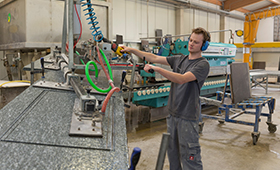Shaping stone by hand and machine
Updated training for stonemason and sculptor
25/2018 | Bonn, 16.05.2018

An occupation spanning both the traditional and the modern: the skilled trade of the stonemason is characterised by the combination of traditional craftsmanship and the use of modern processing methods. Computer-controlled systems and new requirements in materials processing are the reason for the updating of the occupation which has now taken place. On behalf of the Federal Government, and together with social partners and experts from company practice, the Federal Institute for Vocational Education and Training (BIBB) has brought vocational training for stonemasons and stone sculptors up to date. The new regulation enters into force on 1 August 2018.
Many companies now use computer-controlled machines to organise the processing of natural stone more efficiently and to offer new products, for example in interior construction. With the aid of modern equipment, what previously would have taken several working days can now be produced within a few hours. Despite this, there is huge demand for skilled workers able to work on natural stone. This is because orders are completed for clients who value the traditional work of the skilled trade.
The occupational profile for the specialism of stone sculpture includes the making and installation of grave stones, interior construction, construction of facades and monument restoration. In the occupational profile for the specialism of stone masonry, particular importance is given to the artistic creation of objects, for example the designing and making of forms, models, reliefs and sculptures, and the maintenance and restoration of sculptures.
The three-year training ends with a journeyman's examination set by the Chamber of Crafts and Trades. Stonemasons and sculptors mainly find employment at companies which process and manufacture works in stone, but also in the construction sector and with cathedral masonry teams. The training opens up opportunities for advancement and career progression, for example as a master craftsman in stone masonry and sculpture.
The updating of the training regulation means the previous regulation from 2003 has now been replaced. The skeleton curriculum for the vocational school which is aligned with the training regulation has been revised by the Standing Conference of the Ministers of Education and Cultural Affairs (KMK) in parallel with the updating of the training regulation.
For further information, please visit www.bibb.de/de/berufeinfo.php/profile/apprenticeship/101016 (German only)
Image material is available www.bibb.de/pressefotos.
Pont of contact: Daniel Schreiber; email: schreiber@bibb.de
Specimen copy requested if printed.